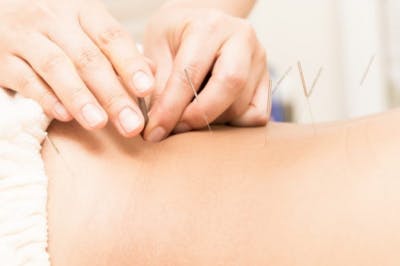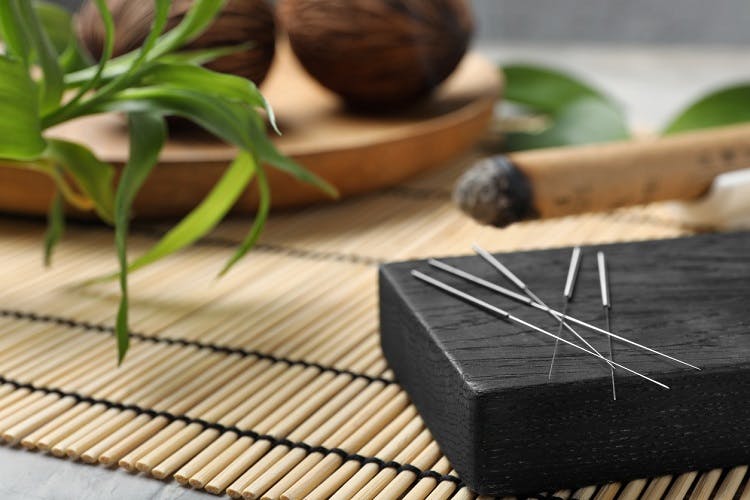Is acupuncture an effective management intervention for cerebral palsy?
Although this traditional form of Chinese medicine has been around for thousands of years, a consensus has yet to be reached.
To help you determine whether acupuncture is worth trying, this article will explain:
- What is Acupuncture?
- How Acupuncture May Help Individuals with Cerebral Palsy
- Benefits of Acupuncture for Cerebral Palsy
- Arguments Against the Use of Acupuncture for CP
What is Acupuncture?
Acupuncture involves placing of thin, hair-like needles on specific points (acupoints) on the body to promote the body’s natural flow of energy (qi).
It’s believed that when an individual’s qi becomes congested, they experience pain, discomfort, stress, or sickness. Therefore, acupuncture is intended to remove those blockages to promote relief.
Another theory suggests that placing needles onto the skin stimulates an immediate inflammatory response to that area of the body, which promotes healing.
While the underlying mechanisms of acupuncture have yet to be completely understood, it has become a popular form of complementary and alternative medicine. However, like all forms of non-conventional treatments, it has its fair share of skeptics due to a lack of concrete scientific evidence.
Although most people do not report feeling pain with the placement of acupuncture needles, the thought of poking into the body may be intimating. For individuals concerned about the use of needles, a related treatment which follows many of the same principles, called acupressure, may be used. Rather than using needles, acupressure involves using specialized instruments, the hands, or another body part to simply apply pressure to the acupoints to promote healing.
In the following section, we’ll discuss how acupuncture may be applied to manage the effects of cerebral palsy.
How Acupuncture May Help Individuals with Cerebral Palsy

Cerebral palsy is a developmental motor disorder caused by brain damage before, during, or shortly after birth. It affects muscle tone, voluntary movement, coordination, balance, and posture. While acupuncture may help relieve some complications related to cerebral palsy, it cannot reverse brain damage.
A modern form of acupuncture called scalp acupuncture combines traditional Chinese acupuncture techniques with Western medical knowledge to stimulate specific areas of the brain. Rather than placing needles on the body, scalp acupuncture involves placing needles on specific points of the scalp.
According to this article, “scalp acupuncture is geared toward stimulating and restoring affected brain tissue, as well as retraining unaffected brain tissue to compensate for the lost functions of damaged tissue.”
While repetitive, active movement is the most effective way to improve motor functions, the extra stimulation from acupuncture may provide the extra boost healthy regions of the brain need to make adaptive changes. As a result, using acupuncture in combination with rehabilitative therapy may be ideal for functional improvement.
More commonly, acupuncture is used to treat chronic pain. Many individuals with cerebral palsy experience pain due to high muscle tone (spasticity), which places excess strain on the muscles and joints. While studies suggest that acupuncture may effectively relieve high muscle tone and pain, further research is necessary.
Next, we’ll discuss other ways acupuncture treatments may be beneficial for individuals with cerebral palsy.
Benefits of Acupuncture for Cerebral Palsy
While acupuncture is most widely accepted as a treatment for minimizing pain, it may also have the potential to relieve additional complications associated with cerebral palsy.
In this analysis of 21 studies regarding the use of acupuncture for cerebral palsy, a total of 1718 participants were studied.
The collective data suggests that acupuncture in combination with rehabilitative training may promote many benefits[1],[2] including:
- improved gross motor function
- reduced muscle spasms
- overall improved quality of life
- improved quality of sleep
- increased mood
- improved bowel function
- heightened bone density
- decreased drooling
Additionally, acupuncture is generally more affordable and has a lower risk of adverse side effects than conventional medications.
In the following section, we’ll discuss arguments against acupuncture for cerebral palsy.
Arguments Against Acupuncture for CP
While the metanalysis mentioned in the previous section suggests cerebral palsy is a promising form of treatment for complications of cerebral palsy, there are a few limitations to consider.
Arguments against acupuncture for the management of cerebral palsy include:
1) Limited evidence. By extensively searching through 6 English databases and 5 Chinese databases, there were only 21 well-designed randomized controlled trials that fit the criteria for analysis.
2) Small sample sizes. The average number of participants out of the 21 trials was 82.
3) Inconsistent methodology and reporting among studies. This suggests that the data may be affected by bias.
Ultimately, more high-quality research is necessary to support claims that acupuncture may be an effective form of treatment for CP.
Is Acupuncture for Cerebral Palsy Management Worth Trying?
Acupuncture is an ancient Chinese practice that has been used for thousands of years to promote healing. While it is most commonly used for pain relief, research suggests acupuncture can also help improve motor functions and relieve high muscle tone in individuals with cerebral palsy.
While high-quality evidence supporting the effectiveness of acupuncture is lacking, it is a relatively affordable practice with minimal risk of side effects. We hope this article helped you understand how acupuncture may help individuals with cerebral palsy.











